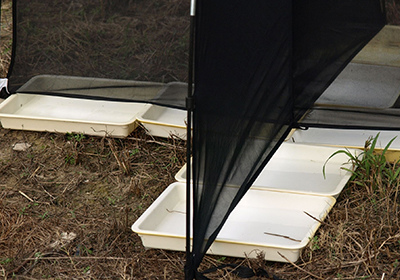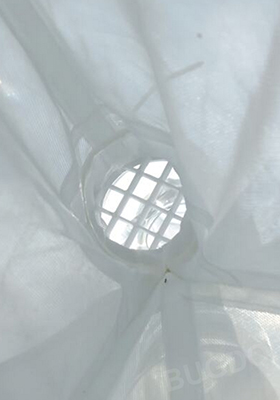Townes-style Malaise trap for standardized insect sampling
This traditional Malaise trap follows the Townes-style design for passive insect sampling. Built with fine mesh and supplied with a 500 ml collection bottle, it provides reliable interception of flying insects for biodiversity surveys and ecological monitoring.
Detailed Description
Malaise traps intercept insects with a central panel that directs them upward into a collection bottle. The intercept panel measures 165 × 110 cm (5.4 × 3.6 ft) and is made from black polyester no-see-um mesh (96 × 26 mesh per square inch), fine enough to retain minute taxa such as parasitic Hymenoptera. The trap head holds a 500 ml collection bottle that unscrews easily for servicing. When trays with killing agents are placed beneath the intercept panel, the trap can also serve as a flight interception trap (FIT, or window trap), collecting insects such as beetles that drop after impact.
Window Trap Setup
 Window Trap Setup
Window Trap Setup
The inverted Y-shaped collection head is molded from solid polycarbonate (PC) for durability, UV resistance, and high transparency. Ventilation ports, closed by default, allow optional airflow, and some studies report increased catch efficiency when airflow is enhanced. A removable moth excluder with 1 × 1 cm grid spacing limits entry of larger insects (e.g., Lepidoptera) and reduces wing-scale contamination.
Removable Moth Excluder
 Removable Moth Excluder
Removable Moth Excluder
âš Ensure the ribbons at the junction where the fabric funnel meets the collection head are tied firmly around the head body, and ensure both zip-ties are intact to prevent detachment. Do not overstretch the roof line—apply only gentle tension at the junction.
Proper Collection Head Connection
 Proper Collection Head Connection
Proper Collection Head Connection
Functional Advantages
- Townes-style intercept: Standardized passive sampling for diverse insect taxa without bait.
- Fine mesh retention: 96 × 26 mesh fabric retains minute Hymenoptera and other small insects.
- Collection head: Polycarbonate head with optional airflow vents and a removable moth excluder; replaceable for extended service life.
- Dual function: Can serve as a flight interception trap (FIT, or window trap) with trays placed beneath the central panel.
- Simple servicing: 500 ml collection bottle unscrews for efficient sample handling.
Field Notes
- Placement: Install along trails, forest edges, or streams; orient panel perpendicular to expected insect flight paths.
- âš Head junction: Tie ribbons firmly and ensure zip-ties are intact; keep roof line under gentle tension to prevent detachment.
- Environmental notes: Record sun position and wind direction; provide shade in hot or dry environments to reduce preservative loss.
- Servicing: Empty or replace bottles on a routine schedule; re-tension lines after heavy wind or catch.
- Maintenance: Clean mesh panels periodically to maintain airflow and capture efficiency.
- Alternative setups: For fast deployment, consider the ez-Malaise trap. For canopy or multi-layer sampling, use the SLAM trap. For a traditional field setup, the optional Trap Installation Kit provides tent pegs, guy ropes, and support poles.
ℹ︎Disclaimer: Field Notes provide practical guidance and examples. Actual procedures should be adapted to site conditions, study objectives, and institutional protocols. Users are responsible for safe deployment and compliance with local regulations.
Pack Contents
- 1 × Fabric Trap Body
- 1 × Collection Head (pre-installed)
- 1 × Collection Bottle (pre-installed)
alternative option
Nalgene™ 2105-0016 wide-mouth bottles (53 mm closure; unavailable from this site) are compatible with the supplied bottle.
Additional replacement parts are listed under the Parts tab. Tent pegs, guy ropes, and support poles are not included.
Recent Literature Related to This Product Line (click to search more)
- Organization, usefulness and limitations of an ATBI (All Taxa Biodiversity Inventory): the inventory of terrestrial invertebrates in the Mercantour National Park. Deharveng et al. (2015). Zoosystema, 37(1), 9–30.
- Species identification in Malaise trap samples by DNA barcoding based on NGS technologies and a scoring matrix. Morinière et al. (2016). PLOS ONE, 11(5), e0155497.
- Comparison of Vavoua, Malaise and Nzi traps with and without attractants for trapping of Stomoxys spp. and tabanids on cattle farms. Tunnakundacha et al. (2017). Agriculture and Natural Resources, 51(4), 319–323.
- Revision of Afroserphus Masner (Hymenoptera: Proctotrupidae) with the description of two new species. Buffington et al. (2018). Proc. Entomol. Soc. Washington, 120(4), 687–707.
- Expedited assessment of terrestrial arthropod diversity by coupling Malaise traps with DNA barcoding. deWaard et al. (2019). Genome, 62(3), 85–95.
- Toward a standardized quantitative and qualitative insect monitoring scheme. Hausmann et al. (2020). Ecology and Evolution, 10(9), 4009–4020.
- High species richness of tachinid parasitoids sampled with a Malaise trap in Baihua Mountain Reserve, Beijing. Pei et al. (2021). Scientific Reports, 11(1), 1–10.
- Fluctuating insect diversity, abundance and biomass across agricultural landscapes. Hausmann et al. (2022). Scientific Reports, 12(1), 1–9.
- Extensive regional variation in the phenology of insects and their response to temperature across North America. Dunn et al. (2023). Ecology, e4036.
- Photonic sensors reflect variation in insect abundance and diversity across habitats. Rydhmer et al. (2024). Ecological Indicators, 158, 111483.